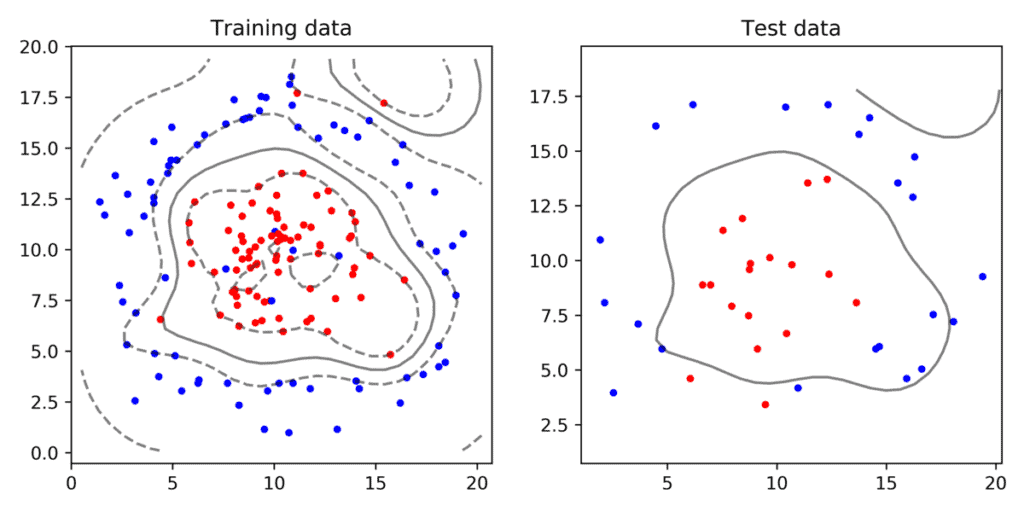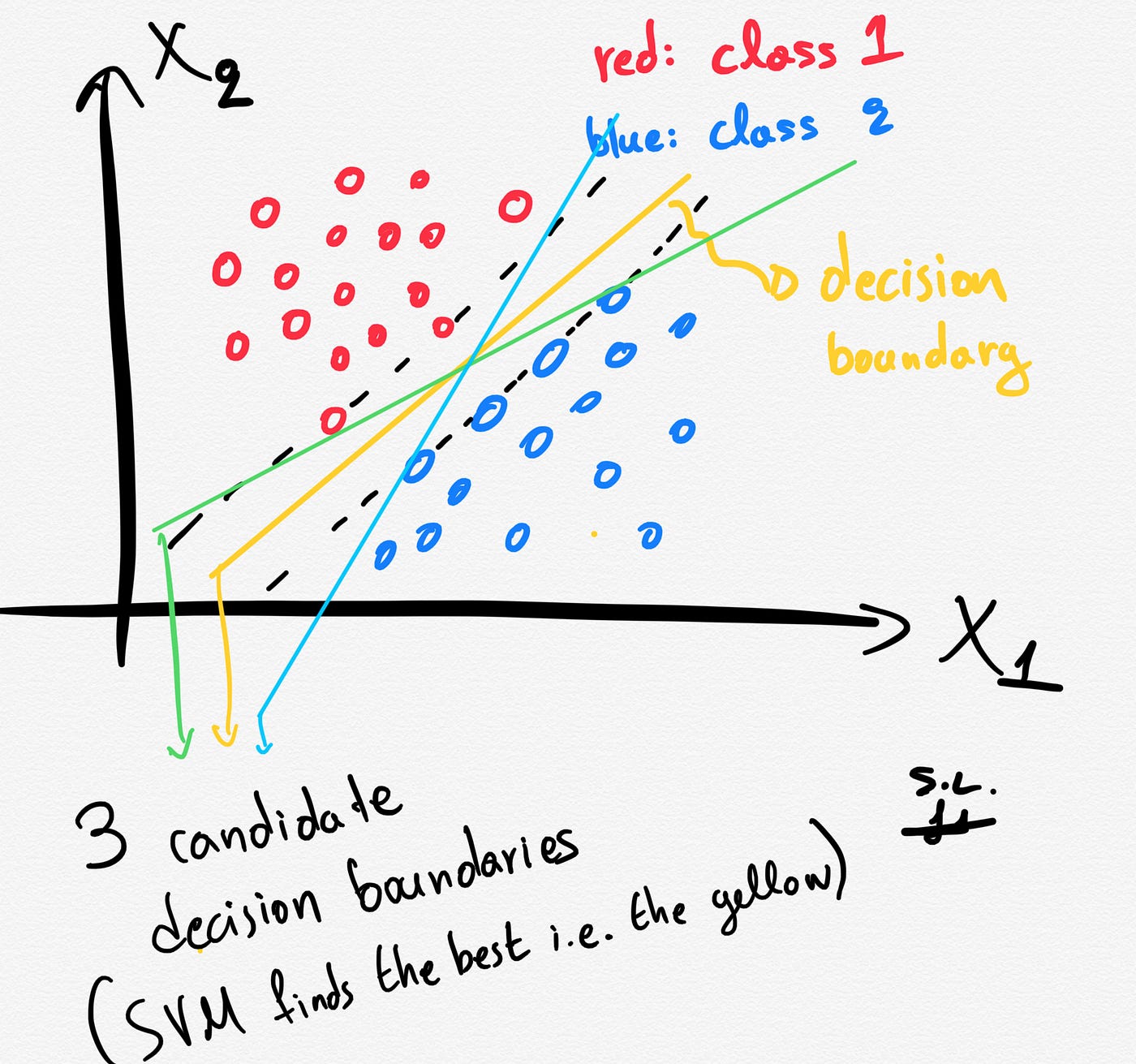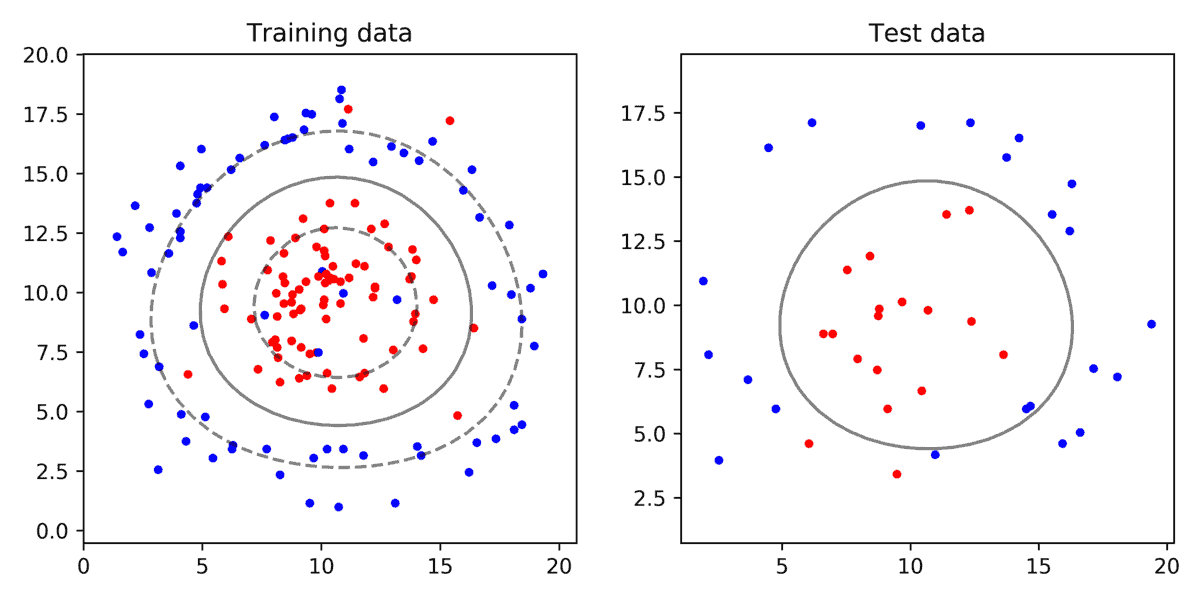Import the support vector classifier function or svc function from sklearn svm module. Now, of course, we can see with our own eyes how these groups should be divided, though exactly where we might draw the dividing line might be debated:
Python Svm Example, Download the dataset and place the data.csv file in the same folder as svm.py. Import numpy as np import matplotlib.pyplot as plt from scipy import stats import seaborn as sns;

Then add this code inside init () function: Import random import math import numpy as np import matplotlib.pyplot as plt from sklearn.svm import svr from sklearn.metrics import mean_squared_error test data is ready. It is mostly used when there are a large number of. In this post, we�ll learn how to fit and predict regression data with svr in python.

SVM Python Examples YouTube Svm(support vector machines) is a supervised machine learning algorithm. (svm) regression in python ##### import pandas as pd. The remaining hyperparameters are set to default values. Build the support vector machine model with the help of the svc function. Y_pred = classifier.predict(x_test) attaching the predictions to test set for comparing.

SVM using ScikitLearn in Python LearnOpenCV You can vote up the ones you like or vote down the ones you don�t like, and go to the original project or source file by following the links above each example. In this post, we�ll learn how to fit and predict regression data with svr in python. #import svm model from sklearn import svm #create a svm classifier clf.

SVM Implementation in Python From Scratch Step by Step Guide in 2021 In this post, you will get an access to python code example for building a machine learning classification model using svm (support vector machine) classifier algorithm. Have a look at the target: Def svm_example(n_samples = 10000, n_features = 100): X = [1, 5, 1.5, 8, 1, 9] y = [2, 8, 1.8, 8, 0.6, 11] then we can graph this.

SVM using ScikitLearn in Python LearnOpenCV Support vector machine (svm) is a supervised machine learning algorithm. Data = pd.read_csv (�./data.csv�) # svm only accepts numerical values. Import random import math import numpy as np import matplotlib.pyplot as plt from sklearn.svm import svr from sklearn.metrics import mean_squared_error test data is ready. You may check out the related api usage on the sidebar. Support vector machine (svm) with.

Support Vector Machines (SVM) clearly explained A python tutorial for # create a linear svm classifier with c = 1 clf = svm.svc (kernel=�linear�, c=1) if you set c to be a low value (say 1), the svm classifier will choose a large margin decision boundary at the expense of larger number of misclassifications. # importing the libraries import matplotlib.pyplot as plt import pandas as pd # importing the dataset.

Machine Learning Tutorial 5 SVM Machine Learning Python for Beginners I am trying to implement this from scratch to really get a good understanding rather then just use libraries to get me through. Svm let’s create a linear kernel svm using the sklearn library of python and the iris dataset that can be found in the dataset library of python. # therefore, we will transform the categories m and b.

python Calculate a pvalue for SVMplots on Iris dataset (2Ddata The remaining hyperparameters are set to default values. The figure below illustrates the effect of. Split the dataset into train and test using sklearn before building the svm algorithm model. From sklearn.svm import svc classifier = svc(kernel=�rbf�, random_state = 1) classifier.fit(x_train,y_train) predicting the classes for test set. Download the dataset and place the data.csv file in the same folder as.

Support Vector Machine Python Example by Cory Maklin Towards Data Have a look at the target: Now, of course, we can see with our own eyes how these groups should be divided, though exactly where we might draw the dividing line might be debated: Support vector machine (svm) with python. Svm(support vector machines) is a supervised machine learning algorithm. From sklearn.svm import svr from sklearn.datasets import make_regression x,y = make_regression(n_samples,.

SVM using ScikitLearn in Python LearnOpenCV Sns.set() next, we are creating a sample dataset, having linearly separable data, from sklearn.dataset.sample_generator for classification using svm − Clf = svm.svc(gamma=0.001, c=100) this chooses the svc, and we set gamma and c. If anyone can find a good example, or possibly explain the process that would be fantastic. This article covers eight parts: # importing the libraries import matplotlib.pyplot.

Support Vector Machines (SVM) clearly explained A python tutorial for The following is an example for creating an svm classifier by using kernels. This article covers eight parts: Now, of course, we can see with our own eyes how these groups should be divided, though exactly where we might draw the dividing line might be debated: Svm let’s create a linear kernel svm using the sklearn library of python and.

Support Vector Machine Python Example by Cory Maklin Towards Data # importing the libraries import matplotlib.pyplot as plt import pandas as pd # importing the dataset dataset = pd.read_csv(�svm_data.csv�) # split the data into inputs and outputs x = dataset.iloc[:, [0,1]].values y = dataset.iloc[:, 2].values # training and testing data from sklearn.model_selection import train_test_split # assign test data size 25% x_train, x_test,. X = [1, 5, 1.5, 8, 1, 9].

Support Vector Machines A Visual Explanation with Sample Python Code For now, we�re not going to get into the purpose of these values. #printing some sample values of prediction. The remaining hyperparameters are set to default values. Import the support vector classifier function or svc function from sklearn svm module. From sklearn.svm import svc classifier = svc (kernel = �rbf�, random_state = 0.

Support Vector Machine Python Example by Cory Maklin Towards Data #printing some sample values of prediction. From sklearn.svm import svc svclassifier = svc (kernel= �sigmoid� ) svclassifier.fit (x_train, y_train) to use the sigmoid kernel, you have to specify �sigmoid� as value for the kernel parameter of the svc class. When c is set to a high value (say. It is one of the most common kernels to be used. Support.

Python implementation of iris data set based on BPNN, decision tree #printing some sample values of prediction. From sklearn.svm import svc svclassifier = svc (kernel= �sigmoid� ) svclassifier.fit (x_train, y_train) to use the sigmoid kernel, you have to specify �sigmoid� as value for the kernel parameter of the svc class. Data = pd.read_csv (�./data.csv�) # svm only accepts numerical values. Create training and test split Def svm_example(n_samples = 10000, n_features =.

Python Programming Tutorials If anyone can find a good example, or possibly explain the process that would be fantastic. I am trying to implement this from scratch to really get a good understanding rather then just use libraries to get me through. For this example, 500 points within a given boundary (note: In this post, you will get an access to python code.

Support vector machine (Svm classifier) implemenation in python with The following steps will be covered for training the model using svm: Finally, let�s use a sigmoid kernel for implementing kernel svm. Support vector machines (svm) is a widely used supervised learning method and it can be used for regression, classification, anomaly detection problems. The hyperparameters such as kernel, and random_state to rbf, and 0 respectively. #printing some sample values.

Support Vector Machine Python Example by Cory Maklin Towards Data If anyone can find a good example, or possibly explain the process that would be fantastic. The hyperparameters such as kernel, and random_state to rbf, and 0 respectively. #printing some sample values of prediction. Svc, nusvc, svr, nusvr, linearsvc, linearsvr and oneclasssvm implement also weights for individual samples in the fit method through the sample_weight parameter. Sns.set() next, we are.

Support vector machine (Svm classifier) implemenation in python with The figure below illustrates the effect of. The following is an example for creating an svm classifier by using kernels. #import svm model from sklearn import svm #create a svm classifier clf = svm.svc(kernel=�linear�) # linear kernel #train the model using the training sets clf.fit(x_train, y_train) #predict the response for test dataset y_pred = clf.predict(x_test) evaluating the model Build the.

Support Vector Machine Python Example by Cory Maklin Towards Data In this post, you will get an access to python code example for building a machine learning classification model using svm (support vector machine) classifier algorithm. We will start by importing following packages −. # therefore, we will transform the categories m and b into. We can determine the number of models that need to be built by using this.

Support Vector Machine Python Example by Cory Maklin Towards Data Def svm_example(n_samples = 10000, n_features = 100): The hyperparameters such as kernel, and random_state to rbf, and 0 respectively. From sklearn.svm import svc classifier = svc (kernel = �rbf�, random_state = 0. Import random import math import numpy as np import matplotlib.pyplot as plt from sklearn.svm import svr from sklearn.metrics import mean_squared_error test data is ready. We will start by.

Implementing Support Vector Machine (SVM) in Python DatabaseTown We can determine the number of models that need to be built by using this formula: Split the dataset into train and test using sklearn before building the svm algorithm model. The remaining hyperparameters are set to default values. (svm) regression in python ##### import pandas as pd. Y_pred = classifier.predict(x_test) attaching the predictions to test set for comparing.

Support Vector Machine Python Example by Cory Maklin Towards Data Initializing support vector machine and fitting the training data. The svm based classier is called the svc (support vector classifier) and we can use it in classification problems. These examples are extracted from open source projects. Once the dataset is scaled, next, the kernel support vector machine (svm) classifier algorithm is used to create a model. Create training and test.

SVM Example 02 Y_pred = classifier.predict(x_test) attaching the predictions to test set for comparing. #printing some sample values of prediction. Finally, let�s use a sigmoid kernel for implementing kernel svm. We will work with python sklearn package for building the model. From sklearn.svm import svc classifier = svc (kernel = �rbf�, random_state = 0.

SVM using ScikitLearn in Python LearnOpenCV X = [1, 5, 1.5, 8, 1, 9] y = [2, 8, 1.8, 8, 0.6, 11] then we can graph this data using: We will work with python sklearn package for building the model. In this post, we�ll learn how to fit and predict regression data with svr in python. Support vector machine (svm) with python. Take a look at.

machine learning An example using python bindings for SVM library Plt.scatter(x,y) plt.show() the result is: For now, we�re not going to get into the purpose of these values. Once the dataset is scaled, next, the kernel support vector machine (svm) classifier algorithm is used to create a model. # create a linear svm classifier with c = 1 clf = svm.svc (kernel=�linear�, c=1) if you set c to be a.
It is mostly used when there are a large number of. machine learning An example using python bindings for SVM library.
Svc, nusvc, svr, nusvr, linearsvc, linearsvr and oneclasssvm implement also weights for individual samples in the fit method through the sample_weight parameter. # therefore, we will transform the categories m and b into. First, we add the required libraries into our source code. For example, what differs in the way we train a svm with two classes then having three. Now, of course, we can see with our own eyes how these groups should be divided, though exactly where we might draw the dividing line might be debated: Linear kernel is used when the data is linearly separable, that is, it can be separated using a single line.







